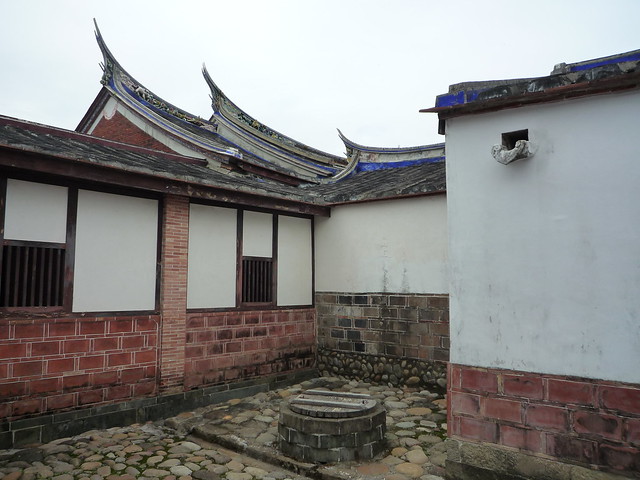The house itself had some beautiful details and luckily our host hired a wonderful tour guide to explain many of them. She was so thorough in explaining all the details so I'll try to remember as much as I can despite this pregnancy brain. This is the rear facade off the courtyard. The tour guide explained that the roof shape is meant to look like the horns of a dragon. As if the dragon is crouching over and protecting the house.
Standard bearer, or base for displaying the flags. There was some language barriers but I believe the guide said, thanks to my lovely translator, that the symbols were of his position within the government. I wish I had better pictures of the plants in the courtyard, there were a few pear trees, Apparently they are a symbol of welcoming.
The guide also said that the wings would be added continually as the family grew. However these brick buildings, in contrast to the white plaster, were original. Additionally the two styles are representative of two local communities in Daxi at the time. The brick buildings are common in Shaoan Hakka architecture, if I remember correctly. And the white plaster walls are more indicative of local craftsmen native to Taiwan. I noticed the plaster buildings, being more living quarters for family than showplaces of the central house, seems brighter, perhaps because the sunlight was reflecting off of adjacent outer walls.
this image is from here, the rest are mine
The guide also explained that the doorways were built with these obstacles forcing you to look down as you stepped into the threshold, thus bowing your head.
Lovely details and carvings.
Central courtyard replete with rain gutters that drained out to the pond adjacent to the house. The guide mentioned that in order to keep the drains clean they would employ turtles to eat any debris that may accumulate. What happens when a lazy turtle decides to lay down on the job? Apparently the popular remedy was to smoke him out!
The house belonged to an official calligrapher so some of his original work is still prominently featured. This was painted in ink onto the plaster while is was still wet in a technique not unlike frescoes.
Original kitchen stove with horizontal stone window slats to protect the cooks from invaders and robbers but still allow for the passage of dishes. The guide made an interesting point that in Feng Shui the window slats should be an even number for horizontal windows while an odd number for vertical windows.
Beautiful brick and tile details. I love the teal glaze on the vents.
Original courtyard well. Much like Georgian design, there was a false well adjacent to achieve a sense of balance - all in the name of Feng Shui.
Cat holes and tunnels for natural pest control.
The gallery.
Incidentally while the tour guide worked for the local government, her family has owned a famous tofu house for generations. So after the tour we were treated to some unique tofu varieties. Architecture then food, my kind of tour!
All photos by me, please credit if you plan to share, thanks!


















Hello Ann, I was at the Lee house also, and it is one of the nicest house museum. Your description is perfect; the only extra thing I remember is that there were interesting displays set up in a number of the rooms.
By the way, when you were in Daxi you were very close to Cihu, the subject of my recent post--did you get to go there?
--Road to Parnassus
Fantastic tour, Ann! Thank you for remembering and sharing so many details. My grandparents' house in Fujian, China had similar features: raised threshold, inner courtyard, peaked roof lines, etc. But obviously much smaller.
Take care,
Loi
PS - I love tofu! Lucky you :)
Post a Comment